ResourcesIdentify A PestRodents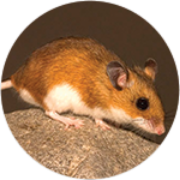
Deer MouseColor: Brown or grey with white feet and underbelly. Tail is dark on top and white on bottom. Legs: 4 Length: 5/8 – 3/4 inch Region: Found across the U.S. 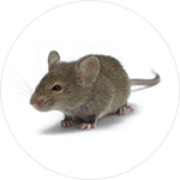
House MouseColor: Brown or grey with a white belly Legs: 4 Length: 1/4 – 1/8 inches (5 – 7 inches with tail) Region: Found across the U.S. 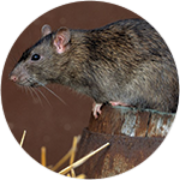
Norway RatsColor: Brown with some black hairs; grayish white underbelly Legs: 4 Shape: Long and heavily bodied, rounded muzzle Length: 7 – 9 1/2 inches Region: Found across the U.S. 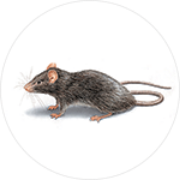
Roof RatsColor: Brown with black intermixed; gray, white or black underside Legs: 4 Shape: Long and thin with scaly tail; large ears and eyes Length: 6 – 8 inches (16 inches with tail) Region: Found in coastal states and the southern third of the U.S but may be found farther north
Cockroaches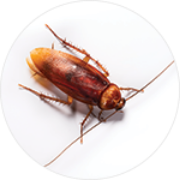
American CockroachThe American cockroach, or palmetto bug,” is the largest house infesting cockroach. Despite its name, the American cockroach is not native to North or South America, but was most likely introduced via ships from Africa in the17th century. Color: Reddish-brown with a yellowish figure 8 pattern on the shield behind its head Legs: 6 Shape: Oval Antennae: Yes Length: Up to 2 inches Region: Found across the U.S. and the world 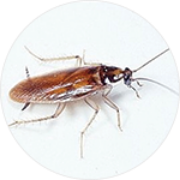
Brownbanded CockroachBrownbanded cockroaches are characterized by the two lighter bands they have across their dark brown bodies. While male brown-banded roaches have full wings that reach beyond the tip of their pointed abdomens, females have underdeveloped wings that don’t allow them to fly. This cockroach is less common than other species, but may be found in multi-unit dwellings or other residential buildings.
Color: Brown with banding across wings Legs: 6 Shape: Oval Antennae: Yes Length: Up to ½ inches Region: Found across the U.S. 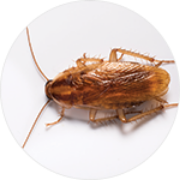
German CockroachThe German cockroach is the most common species of cockroach, found around the world. They prefer to live in cracks and crevices near food and moisture sources, making residential and commercial kitchen environments their perfect home. Color: Light brown to tan, with two dark, parallel stripes on their backs Legs: 6 Shape: Oval Antennae: Yes Length: 1/2 – 5/8 inches Region: Found across the U.S. and the world 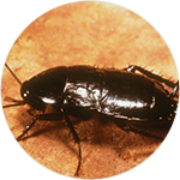
Oriental CockroachOriental cockroaches can be found in sewers and in moist, decaying organic matter. They are also referred to as “waterbugs” and “black beetle cockroaches.” Their immature stages are often confused with the immature stages of American cockroaches. Color: Glossy black Legs: 6 Shape: Oval Antennae: Yes Length: 1 inch long Region: Northern regions of the U.S. Ants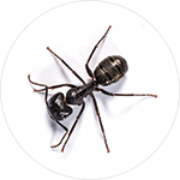
Carpenter AntCarpenter ants are known for excavating wood in order to build their nests. Creating smooth tunnels inside the wood, they leave small piles of sawdust, where you can find dead insects and insect parts mixed in. Color: Often red, black or a combination Legs: 6 Shape: Segmented with 3 main body parts Antennae: Yes and may have wings Length: ¼ – ¾ inch Region: Found across the U.S. 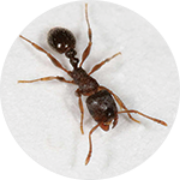
Pavement AntDespite their name, pavement ants can also infest structures. Pavement ant colonies are moderately large, averaging around 4,000 workers with several queens. They can often be recognized by the small mounds of dirt they excavate where they are nesting. Color:Dark brown to blackish Legs: 6 Shape: Segmented with 3 main body regions Antennae: Yes Length: 1/16 – 1/8 inch Region: Found across the eastern half of the U.S., one of the most common ants in the Midwest. 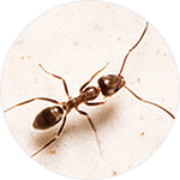
Argentine AntArgentine ant colonies can grow to substantial size. A single colony can contain several hundred thousand workers, their colony borders sometimes covering entire habitats. Color: Light or dark brown Legs: 6 Shape: Segmented with 3 main body parts Antennae: Yes Length: 1/2 – 5/8 inches Region: Found mainly in Southeastern and Southwestern U.S. 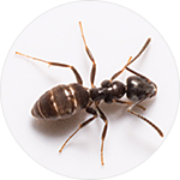
Odorous House AntThe odorous house ant is characterized by the strong, blue cheese odor it gives off when crushed. Color: Black or brown Legs: 6 Shape: Segmented with 3 main body parts Antennae: Yes Length: 1/16 – 1/8 inch Region: Found across the U.S. 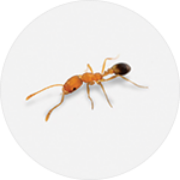
Pharaoh AntPharaoh ants get their name from the mistaken belief that they were one of the plagues of Egypt during the time of Pharaohs. Although they are thought to be native to Africa, Pharaoh ants are currently found throughout the Unites States. Color: Pale body with a dark to black abdomen Legs: 6 Shape: Monomorphic with segmented body; 3 main body parts Antennae: Yes Length: 1/16 inch Region: Found across the U.S. 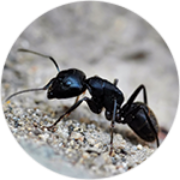
Little Black AntLittle Black Ant colonies are moderate to very large and contain many queens. Color: Dark brown or black Legs: 6 Shape: Segmented with 3 main body parts Antennae: Yes Length: 1/16 inch Region: Found across the U.S. Flies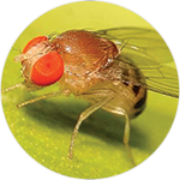
Small Fruit FlyFruit flies get their common name from their small size and affinity for over ripening fruits and vegetables. They have been shown to vector food borne pathogens such as E coli. Color: Tan / light with light and dark banding on the abdomen and red eyes Legs: 6 Antennae: Yes, short in length Length: 1/8 inch Region: Found across the U.S. 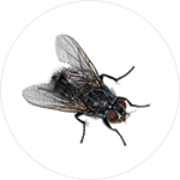
House FlyHouse flies get their name from being the most common fly found in homes. Adult house flies usually live between 15 and 25 days, completing their life cycle in as short a time as 7 days. Color:Dark gray with four dark stripes on the area behind the head Legs: 6 Antennae: Yes Length: ¼ inch Region: Found across the U.S. 
Phorid FlyPhorid flies will feed on all types of decaying plant and animal matter. Color: Tan to black with a few dark veins on their wings Legs: 6 Shape: Humped back appearance Antennae: Yes, short in length Length: 1/64 – 1/4 inch Region: Found across the U.S. 
Drain/Moth FlyDrain flies are often rest on surfaces and are fairly easy to swat and kill. The immature stages feed on bacteria, algae and fungi living in the slime layer of drains and water treatment plants. Color: Light gray to black in color Legs: 6 Shape: Wings are lemon shaped Antennae: Yes, short in length Length: 1/16 – 3/16 inch Region: Found across the U.S. 
Bottle FlyBottle flies are attracted to lights and will often be found inside insect light traps and along windows. They are excellent fliers and some species may travel over 20 miles. Color: Shiny metallic in color ranging from blue, green, black or brassy Legs: 6 Shape: Small oval Antennae: Yes Length: 1/8 – 5/8 inch Region: Found across the U.S. Stored Product Pests
Indian Meal MothColor: Copper reddish on outer part of wings Legs: 6 Shape: Elongated oval Antennae: Yes Length: 5/8 – 3/4 inch Region: Found across the U.S. 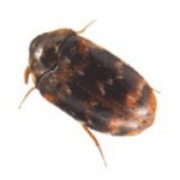
Warehouse BeetleColor: Brownish black with yellow marks Legs: 6 Shape: Oval Antennae: Yes Length: 1/4 – 1/8 inch Region: Found across the U.S. 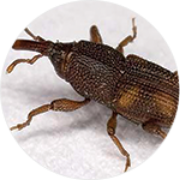
Rice WeevilColor: Reddish-brown to black Legs: 6 Shape: There are small round pits on the thorax Antennae: Yes Length: 1/8 inch Region: Found across the U.S. 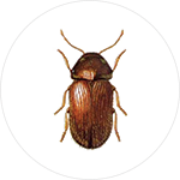
Drugstore BeetleColor: Brown Legs: 6 Shape: Oval Antennae: Yes Length: 1/8 inch Region: Found across the U.S. 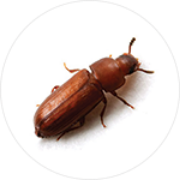
Flour BeetleColor: Reddish brown Legs: 6 Shape: Elongated oval Antennae: Yes Length: 1/8 inch Region: Found across the U.S. Bed Bug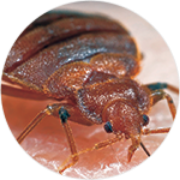
Bed BugBed bugs are found in virtually every place people tend to gather, including residences, hotels, schools, offices, retail stores and even public transportation. Color: Mahogany to red-brown Legs: 6 Shape: Flat, broad oval when unfed; swollen when fed Antennae: Yes Length: 1/4 inch long Region: Found across the U.S. and the world Other Pests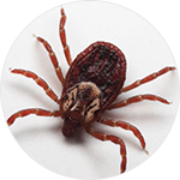
American Dog TickThe American dog tick gets its name from the fact that adult ticks prefer domestic (American) dogs as hosts. Color: Brown with whitish to gray markings Legs: Larvae have 6 legs, nymphs and adults have 8 legs Shape: Oval, flattened Antennae: No Length: 3/16 inch un-engorged, 5/8 inch engorged Region: Found across the U.S. except the Rocky Mountains area 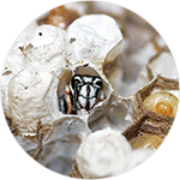
Bald-faced HornetThe bald-faced hornet is a relative of the yellow jacket and gets its name from its black body and white face. Color: Black with a white pattern on its face Legs: 6 Shape: Traditional wasp shaped body Antennae: Yes Length: 1/2 – 5/8 inch Region: Found across the U.S. 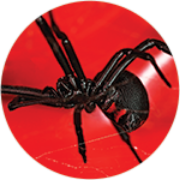
Black Widow SpiderBlack widow spiders are most recognized for the red hourglass shape under their abdomen. They get their name from the myth that the female black widow spider eats the male after mating—but this rarely happens. Black widows are poisonous only when ingested during the first 17 days of their life. Color: Black, with characteristic red “hourglass” on back Legs: 8 Shape: Two main body segments Antennae: No Length: 1 ½ – 1 3/8 inches Region: Found across the U.S. 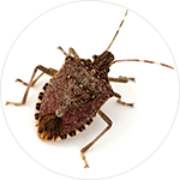
Brown Marmorated Stink BugBrown marmorated stink bugs are an invasive species from Asia that arrived in Pennsylvania in 1996. The stink bug earned its name from its ability to release an odor when disturbed or crushed. Color: Mottled grayish-brown Legs: 8 Shape: Triangular or shield Antennae: Yes Length: 3/4 inch Region: Found in the eastern half of the U.S., as well as California, Oregon, Washington, Arizona, New Mexico, and Texas 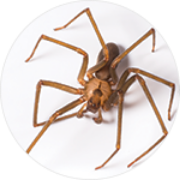
Brown Recluse SpiderBrown recluse spiders have a characteristic dark brown violin-like mark on their back. These spiders often infest cedar shake roofs and spin irregular webs. Color: Light to dark brown, with characteristic dark brown violin mark Legs: 8 Shape: Two main body segments Antennae: No Length: 1/2 - 1/4 inch Region: Found in the south central Midwest from Ohio to Nebraska and south through Texas to Georgia 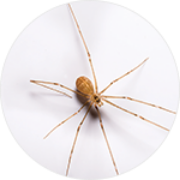
Cellar SpiderLong-bodied cellar spiders are found in dark and damp places like cellars and basements. There are approximately 20 species of cellar spiders in the United States and Canada. Color: Pale yellow, light brown, or gray Legs: 8 Shape: Long skinny legs with a small body Antennae: No Length: 1/2 - 3/8 inch Region: Found across the U.S. an Canada 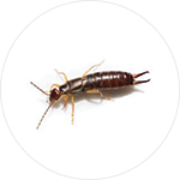
EarwigEarwigs got their name from the myth that they crawl into sleeping people’s ears and tunnel into their brains. The long cerci, or forceps, on their backsides easily distinguish an earwig. Color: Dark brown Legs: 6 Shape: Long, narrow Antennae: Yes Length: 5/8 inch Region: Found across the U.S. 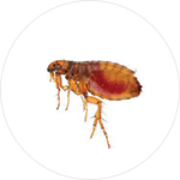
FleaFleas are parasites that feed on the blood of any warm-blooded animal. The most common species is the cat flea, which often feasts on cats, dogs and humans. Color: Dark, reddish-brown Legs: 6 Shape: Flat Antennae: Yes Length: 1/12 - 1/6 inch Region: Found across the U.S. 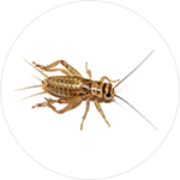
House CricketHouse crickets are known for their loud chirping, produced by friction created by their wings. Color: Yellowish brown with 3 dark cross bands on their head Legs: 6 Shape: Long, winged as adults Antennae: Yes Length: 3/4 – 7/8 inch Region: Found across the U.S. and the world 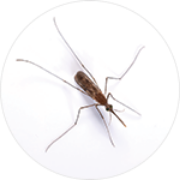
MosquitoOne of the best-known summer pests, mosquitoes breed in stagnant water or soft soil. There are about 170 different kinds of mosquito species in North America alone. Color: Varies; mostly gray with white, silver, green or blue scales Legs: 6 Shape: Narrow, oval Antennae: Yes Length: 1/4 - 3/8 inch Region: Found across the U.S. 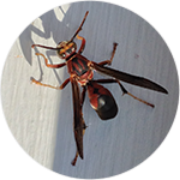
Paper WaspPaper wasps are sometimes called umbrella wasps, after the shape of their distinctive nests Color: Brownish with yellow markings; a few species with reddish markings Legs: 6 Shape: Traditional wasp shape with pinched waist Antennae: Yes Length: 5/8 - 3/4 inch Region: Found across the U.S. 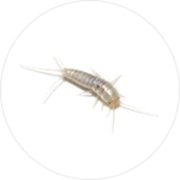
SilverfishThis insect gets its name from its silvery, metallic appearance and fish-like shape and movements. They tend to go unnoticed by humans, which means any damage they have caused could go unnoticed for a long time. Color: Silver to brown Legs: 6 Shape: Oval, elongated Antennae: Yes Length: 3/4 inches Region: Found across the U.S. 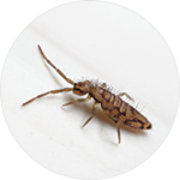
SpringtailCertain species of springtails are referred to as “snow fleas” when found in winter, but they are not fleas at all. Springtails get around by jumping, using a unique catapult system. Their jumping is especially noticeable against white snow. Color: Creamy white to dark brown/black Legs: 6 Shape: Segmented, oblong Antennae: Yes Length: 1/16 inch Region: Found across the U.S. 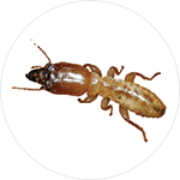
Subterranean TermiteColor: Creamy white to dark brown/black Legs: 6 Shape: Long, narrow and oval Antennae: Yes Length: 1/8 inch long Region: Found across the U.S. 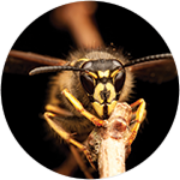
Yellow JacketThere are several species of yellow jackets in the United States. These flying insects typically have a yellow and black head and face with patterned abdomen. Color: Abdomen usually black and yellow Legs: 6 Shape: Traditional wasp shape Antennae: Yes Length: 3/8 to 5/8 inch Region: Found across the U.S. |